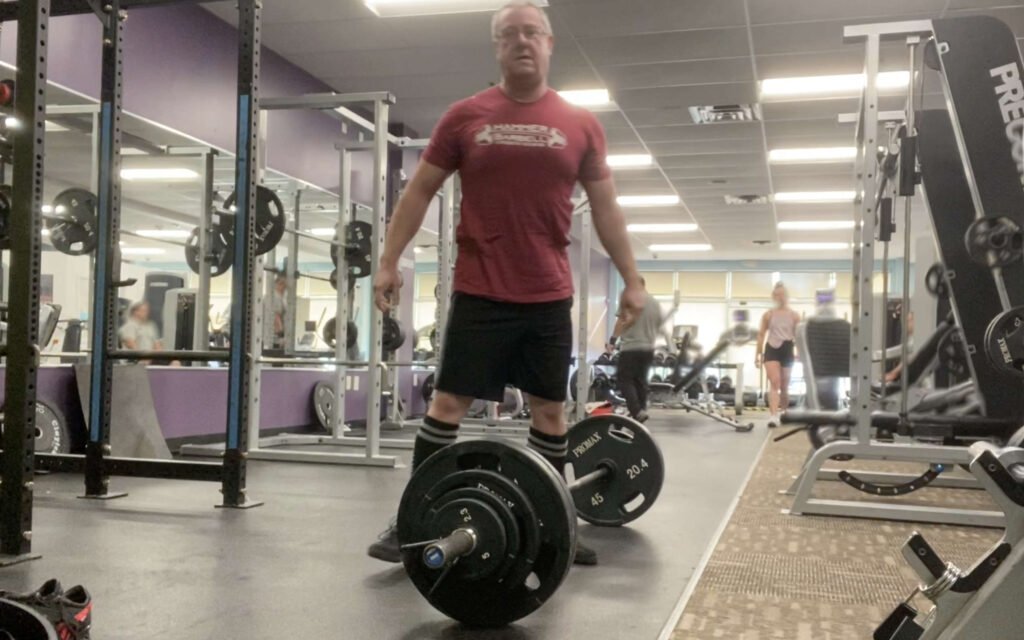[ad_1]
Is it true that a 50 year old man can get in shape, even if he hasn’t been physically active?
Before we discuss this, let us first discuss what is happening to the majority of 50 year old men…
Did you know that by the age of 50 physically inactive people may have lost 10% of their muscle mass?
This type of losing muscle from aging is scientifically known as sarcopenia [1] and is becoming increasingly common.
Did you know that 12.4% of the US population ages 45 – 64 have Type 2 diabetes?
According to the CDC data [2] for 2018 over 1 in every 10 people between the ages of 45 and 64 have medically diagnosed Type 2 diabetes. This number increases when you factor in the people who are pre-diabetic and the many who are undiagnosed. The biggest worry of this statistic is that the figure rises to 21.4% in the age group of 65 – 74 year olds …. this is one in every 5 people.
What can a Fifty Year Old Do About This?
The conventional wisdom is that with enough will power people can somehow reverse their life choices.
The reality is that for a period of time these people are motivated enough to start with a change – be that a diet or exercise regimen – but so many give up because life gets in the way.
If the reason for doing it isn’t strong enough then these life interruptions will halt that diet, or halt the going to the gym, such that they become distant memories and all the good achieved is quickly reversed.
Who can look at themselves and admit that they have done this at least once in their life? Maybe it has been many times, bouncing from one diet to the next and wondering why the pounds just seem to keep on piling on?
The true reality is that dieting in isolation is really hard, especially for the long haul. Let us all be realistic – there are just too many temptations out there for us not to stray.
And those temptations taste so good…. just one more, and another, and another…
So someone decides to get a gym membership to ‘get in shape’. Starts to go regularly to the gym and jumps on the treadmill, elliptical and/or cycle.
After spending an hour on that and getting a great sweat, may go over to some of the isolation machines and use a few of them, and finally may finish with some dumbbell moves.
Due to the current enthusiasm that person just repeats these steps, until either that enthusiasm wanes, or something in their life gets in the way.
When reflecting on progress they look at those love handles that are still there and wonder what was the use of all that time spent at the gym?
Once again who can look at themselves and not relate to this?
We’re all told that diet and exercise are all that we need to do, by our peers, by our doctors and the media.
As we have discussed this is easier said than actually done.
I personally didn’t even bother with diets or exercise and for context this is what I used to look like:
What Worked for Me
Very simply – I learned how to train for strength.
In 2018 I had some lessons from a strength coach who taught me how to correctly and safely squat, bench press, (overhead) press and deadlift. I cannot say that any of these moves came naturally, and they certainly were not comfortable!
However he convinced me to join his training program with the question “Can you give me 3 hours per week”.
With that question how could I refuse??
and what did I have to lose, other than the cost of the program?
“Can you give me 3 hours per week?”
I detail what happened in other articles in this blog, but in summary:
At the time I had no idea why this worked – I just did what I was told. A couple of years later I subsequently completed the 6 month long Barbell Logic Coaching Academy and learned the science behind why this simple process actually works, as well as the reasons why many others do not.
Is Strength Training Backed by Science?
Yes, this is fully backed by science and works for anyone of any age and gender. Indeed as I started to educate myself more about why this seemed so miraculous I was amazed (and comforted) to find out just how many M.D.’s are involved in barbell strength training.
This is simply because of the medicinal benefits that training with barbells can endow on anyone.
Indeed Dr. Jonathon Sullivan has written and published a book called “The Barbell Prescription” detailing this, and the benefits of strength training for life after 40. I encourage anyone to research more at Dr. Sullivan’s gym website called Greysteel.
While Dr. Sullivan talks to the older demographic Dr. Jordan Feigenbaum and Dr. Austin Baraki at Barbell Medicine have a trove of information, research and products for the general population.
(I want to point out that I am in no way affiliated with these organizations – they just do great stuff and well worth researching for yourself)
Looking For Inspiration?
For those who are unsure if 50 is too late to reverse aging and get strong, here is an inspiring real-life documentary of John Claassen. John started strength training at the age of 87, and at the age of 91 entered into his first ever strength lifting competition.
Conclusion
Yes I believe that a fifty year old can get into shape, even if they have not been dedicated to doing so previously.
Why? well that was me and growing old unhealthily scared me more than doing what was necessary to get into shape.
There are many coaches and trainers out there who do work with people in their fifties, but are themselves much younger.
I believe there is no better testament to someone who has the aches and pains, was not particularly strong or healthy to start with, and yet managed to turn it around to be in the best shape of my life.
When i started out I committed myself to being a human guinea pig and have now realized that this is now an integral part of my lifestyle.
Do I want to go backwards… an emphatic no from me!
Personally I want to stay in shape in my fifties, sixties, seventies and beyond.
Do you agree?
Am I wrong?
Does it make any difference to our overall outcomes?
Click here to get Lupus Holistic Care Plan discounted price while it’s still available…
[ad_2]



2 Comments
Gives us our time back, lets us focus on work. Efficiency experts discovered. Productivity boost.
Dry Cleaning in New York city by Sparkly Maid NYC